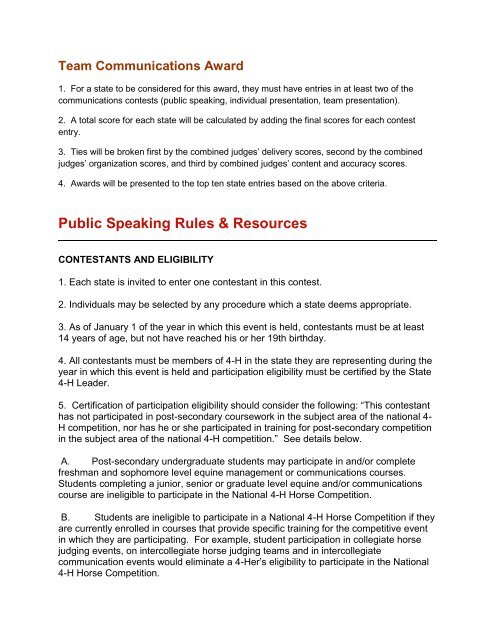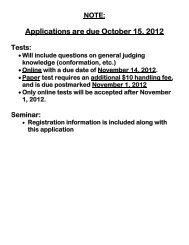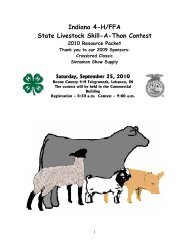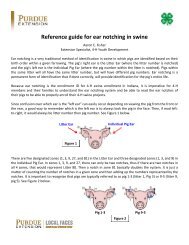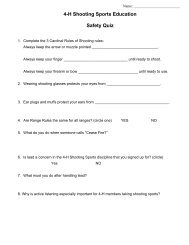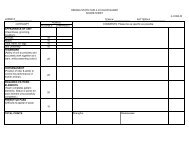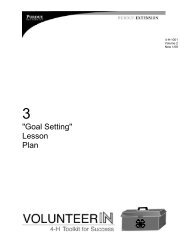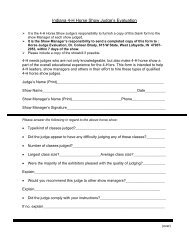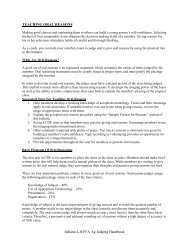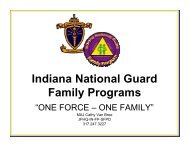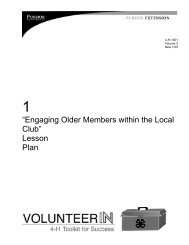Communications Contests - Indiana 4-H
Communications Contests - Indiana 4-H
Communications Contests - Indiana 4-H
Create successful ePaper yourself
Turn your PDF publications into a flip-book with our unique Google optimized e-Paper software.
Team <strong>Communications</strong> Award1. For a state to be considered for this award, they must have entries in at least two of thecommunications contests (public speaking, individual presentation, team presentation).2. A total score for each state will be calculated by adding the final scores for each contestentry.3. Ties will be broken first by the combined judges’ delivery scores, second by the combinedjudges’ organization scores, and third by combined judges’ content and accuracy scores.4. Awards will be presented to the top ten state entries based on the above criteria.Public Speaking Rules & ResourcesCONTESTANTS AND ELIGIBILITY1. Each state is invited to enter one contestant in this contest.2. Individuals may be selected by any procedure which a state deems appropriate.3. As of January 1 of the year in which this event is held, contestants must be at least14 years of age, but not have reached his or her 19th birthday.4. All contestants must be members of 4-H in the state they are representing during theyear in which this event is held and participation eligibility must be certified by the State4-H Leader.5. Certification of participation eligibility should consider the following: “This contestanthas not participated in post-secondary coursework in the subject area of the national 4-H competition, nor has he or she participated in training for post-secondary competitionin the subject area of the national 4-H competition.” See details below.A. Post-secondary undergraduate students may participate in and/or completefreshman and sophomore level equine management or communications courses.Students completing a junior, senior or graduate level equine and/or communicationscourse are ineligible to participate in the National 4-H Horse Competition.B. Students are ineligible to participate in a National 4-H Horse Competition if theyare currently enrolled in courses that provide specific training for the competitive eventin which they are participating. For example, student participation in collegiate horsejudging events, on intercollegiate horse judging teams and in intercollegiatecommunication events would eliminate a 4-Her’s eligibility to participate in the National4-H Horse Competition.
6. If a State decides to change whether it will attend the Eastern or Western NationalContest from its participation the previous year, the Contest Management CommitteeChair of both events are to be notified of the decision by April 1 of the current year. Allrepresentative teams of that state must attend that same event.7. Contestants (including alternates) may participate in only one contest per year at theRoundup. After competing in this contest, they are ineligible to compete in the samespecific contest again. Contestants must not have competed previously in this contest inthe Eastern National 4-H Horse Roundup in Louisville or the Western National 4-HHorse Class in Denver.THE CONTEST1. The subject must pertain to the equine industry. Speeches, not appropriately relatedto the equine industry can be disqualified at the discretion of the judges.2. No visual aids may be used.3. No coaching from parents or coaches during the speech.4. Contestants may use notes. However, excessive use of notes may be countedagainst the contestant. This will be at the discretion of the judges.5. A public address system will not be used during the contest, but a podium will beprovided.6. During the event, the contestants may introduce themselves by name, state andspeech topic.7. Speeches should be 7-10 minutes in length. Three points will be deducted from thetotal score on each judge’s score sheet for every minute (or fraction of a minute) under7 minutes or over 10 minutes.8. Contestants should cite their major references after the conclusion of their speech.This time will not be counted in the allotted time.9. Only the judge(s) may ask questions of the contestant in the contest. Question timewill not be counted in the allotted time. Contestants should repeat the question thenanswer it.10. Contestants may use video recorders to tape their own presentations. It is theresponsibility of the coach/speaker to provide all necessary recording equipment.
11. No videotaping or photographing of presentations is allowed during the contest,except by respective coaches or their designees.12. Contestant order will be determined by a random drawing and will be announced atthe Coaches meeting.13. Three judges will be used and judges will score each entry independently andassign scores. After all presentations are presented and scores are tabulated, judgesmay confer and discuss evaluations. Each judge assigns his or her final scores andthen cumulative final scores are tabulated to determine the final placings. <strong>Contests</strong>uperintendents may review and check tabulation of scores for mathematical accuracy.14. Ties will be broken first by the judges’ accumulated delivery score, second by thejudges’ accumulated organization score and third on content and accuracy score.15. Improper attire will be a violation and appropriate points deducted on the scorecard.Improper attire will be determined at the discretion of the judges. Business attire ordress appropriate to the speech is acceptable.16. The judges will consider the questions listed under each section. The points on thescore card will be as follows:A. INTRODUCTION 10 points1. Did the introduction serve to create interest in the subject?2. Was the introduction short and to the point?B. ORGANIZATION 15 points1. Were the main points easy to follow?2. Were the main points arranged in the best order?3. Were the sentences short and easy to understand?4. Was the speech interesting?
C. CONTENT AND ACCURACY 20 points1. Were the facts and information accurate?2. Was there enough information concerning the subject?3. Was credit given to the sources of information, if it was appropriate?4. Was the content appropriately related to the equine industry?D. STAGE PRESENCE 15 points1. Was the speaker neat and appropriately dressed?2. Did the speaker talk directly to and look at the audience?3. Was the speaker’s posture erect, but not stiff?4. Did the speaker refrain from leaning on the podium?5. Did the speaker seem relaxed and at ease?E. DELIVERY 20 points1. Did the speaker have appropriate voice control?2. Were all word pronounced correctly?3. If notes were used, was it done without detracting from the speech?4. Did the speaker seem to choose words at the time they were spoken as opposed to amemorized or ready-type delivery?F. GENERAL 10 points1. Did the speaker convey to the audience a sense of wanting to communicate?2. Did the speech reflect the thoughts and personality of the speaker?G. CONCLUSION 10 points1. Was the conclusion short and interesting?2. Did the conclusion properly wrap up the speech?3. Could the speaker handle questions easily?
Individual Presentation Rules & ResourcesCONTESTANTS AND ELIGIBILITY1. Each state is invited to enter one contestant in this contest.2. Individuals may be selected by any procedure which a state deems appropriate.3. Contestants must be at least 14 years of age, but not have reached his or her 19thbirthday as of January 1 of the year in which this event is held.4. All contestants must be members of 4-H in the state they are representing during theyear in which this event is held and participation eligibility must be certified by the State4-H Leader.5. Certification of participation eligibility should consider the following: “This contestanthas not participated in post-secondary coursework in the subject area of the national 4-H competition, nor has he or she participated in training for post-secondary competitionin the subject area of the national 4-H competition.” See details below.A. Post-secondary undergraduate students may participate in and/or completefreshman and sophomore level equine management or communications courses.Students completing a junior, senior or graduate level equine and/or communicationscourse are ineligible to participate in the National 4-H Horse Competition.B. Students are ineligible to participate in a National 4-H Horse Competition if they arecurrently enrolled in courses that provide specific training for the competitive event inwhich they are participating. For example, student participation in collegiate horsejudging events, on intercollegiate horse judging teams and in intercollegiatecommunication events would eliminate a 4-Her’s eligibility to participate in the National4-H Horse Competition.6. If a State decides to change whether it will attend the Eastern or Western NationalContest from its participation the previous year, the Contest Management CommitteeChair of both events are to be notified of the decision by April 1 of the current year. Allrepresentative teams of that state must attend that same event.7. Contestants (including alternates) may participate in only one contest per year at theRoundup. After competing in this contest, they are ineligible to compete in the samespecific contest again. Contestants must not have competed previously in this contest inthe Eastern National 4-H Horse Roundup in Louisville or the Western National 4-HHorse Class in Denver.
THE CONTEST1. The subject must pertain to the horse industry. Presentations not appropriatelyrelated to the horse industry can be disqualified at the discretion of the judges.2. The presentation may be a demonstration or illustrated talk. All references to theterm “presentation” in these rules include either demonstration or illustrated talk. Ademonstration is defined as a presentation of a step by step procedure with an endproduct or result. An illustrated talk is defined as a presentation of an idea or topic thatuses visual aids to convey the message.Both presentation forms are acceptable and will be evaluated equally, although thedelivery methods are different as defined above. Both should utilize visual aids to helpconvey the major points of the presentation and more than one type of visual aid ispreferable. Visual aids may include but are not limited to: handouts, posters, props,videos, slides, and computer generated media (PowerPoint, websites, etc.). No liveanimals may be used.3. Contestants may use notes. However excessive use of notes may be countedagainst the contestant. This will be at the discretion of the judge(s).4. A public address system will NOT be used during the contest.5. Participants must supply their own props. Two tables and chairs will be provided forthe presenter’s use. Contestants must provide all of their own equipment.6. Creative audio visual aids may be used but the contestant must be involved inmaking or designing them.7. During the contest, the contestants may introduce themselves by name, state andpresentation topic.8. Presentations should be 9-12 minutes in length. Three points will be deducted fromthe total score on each judge’s score sheet for every minute (or fraction of a minute)under 9 minutes or over 12 minutes.9. Contestants should cite their major references after the conclusion of theirpresentation. This will not be counted in the allotted time.10. No coaching from parents or coaches during the presentation.11. Contestants may use video recorders to tape their own presentations. It is theresponsibility of the team coach/team to provide all necessary recording equipment.
12. No videotaping or photographing of presentations is allowed during the contest,except by respective team coaches or their designees.13. Contestant order will be determined by a random drawing and will be announced atthe coaches’ meeting.14. Only the judge(s) may ask questions of the contestant in the contest. Question timewill not be counted in the allotted time. Contestants should repeat the question thenanswer it.15. Improper attire will be a violation and appropriate points deducted on thescorecard. Improper attire will be determined at the discretion of the judges. Businessattire or dress appropriate to the speech is acceptable.16. Three judges will be used and judges will score each entry independently andassign scores. After all presentations are presented and scores are tabulated, judgesmay confer and discuss evaluations. Each judge assigns his or her final scores andthen cumulative final scores are tabulated to determine the final placings. <strong>Contests</strong>uperintendents may review and check tabulation of scores for mathematical accuracy.17. Ties will first be broken by the judges’ accumulated delivery score, second by thejudges’ accumulated organization score and third on content and accuracy score.18. The judges will consider the questions listed under each section. The points on thescore card will be as follows:A. INTRODUCTION 10 points1. Did the introduction serve to create interest in the subject?2. Was the introduction short and to the point?
B. ORGANIZATION 25 points1. Was only one main idea demonstrated?2. Did the discussion relate directly to each step as it was shown?3. Was each step shown just as it should be done in an actual situation or was athorough explanation given?4. Could audience see each step and/or visual aid?5. Were the materials and equipment carefully selected, neatly arranged and wellorganized?6. Were visual aids used if and when they were needed?7. Were the key points for each step stressed?C. CONTENT AND ACCURACY 25 points1. Were the facts and information presented accurate?2. Was there enough information presented about the subject?3. Were approved practices used?4. Was credit given to the sources of information, if it was appropriate?5. Was the content appropriately related to the horse industry?D. STAGE PRESENCE 10 points1. Were the presenters neat and appropriately dressed for the subject of thepresentation?2. Did the presenter speak directly to and look at the audience?3. Was the presentation too fast or too slow?
E. DELIVERY 15 points1. Did the presenter appear to enjoy giving presentation?2. Did the presenter have good voice control?3. Were all words pronounced correctly?4. If notes were used, was it done without detracting from the presentation?5. Did the presenter seem to choose words at the time they were spoken as opposed toa memorized presentation?F. EFFECT ON AUDIENCE 5 points1. Did the audience show an interest in the presentation?2. Could the audience go home and carry out the idea?G. SUMMARY 10 points1. Was the summary short and interesting?2. Were the key points briefly reviewed?3. Did the summary properly wrap up the presentation?4. Could the presenter handle questions easily?
Team Presentation Rules & ResourcesCONTESTANTS AND ELIGIBILITY1. Each state is invited to enter one team consisting of two members for this contest.2. Teams may be selected by any procedure which a state deems appropriate.3. Contestants must be at least 14 years of age, but not have reached his or her 19 thbirthday as of January 1 of the year in which this event is held.4. All contestants must be members of 4-H in the state they are representing during theyear in which this event is held and participation eligibility must be certified by theState 4-H Leader.5. Certification of participation eligibility should consider the following: “This contestanthas not participated in post-secondary coursework in the subject area of thenational 4-H competition, nor has he or she participated in training for postsecondarycompetition in the subject area of the national 4-H competition.” Seedetails below.A. Post-secondary undergraduate students may participate in and/or completefreshman and sophomore level equine management or communicationscourses. Students completing a junior, senior or graduate level equineand/or communications course are ineligible to participate in the National4-H Horse Competition.B. Students are ineligible to participate in a National 4-H Horse Competition ifthey are currently enrolled in courses that provide specific training for thecompetitive event in which they are participating. For example, studentparticipation in collegiate horse judging events, on intercollegiate horsejudging teams and in intercollegiate communication events wouldeliminate a 4-Her’s eligibility to participate in the National 4-H HorseCompetition.6. If a State decides to change whether it will attend the Eastern or Western NationalContest from its participation the previous year, the Contest Management CommitteeChair of both events are to be notified of the decision by April 1 of the current year. Allrepresentative teams of that state must attend that same event.7. Contestants (including alternates) may participate in only one contest per year at theRoundup. After competing in this contest, they are ineligible to compete in the samespecific contest again. Contestants must not have competed previously in this contest in
the Eastern National 4-H Horse Roundup in Louisville or the Western National 4-HHorse Class in Denver.THE CONTEST1. The subject must pertain to the horse industry. Presentations not appropriatelyrelated to the horse industry can be disqualified at the discretion of the judges.2. The presentation may be a demonstration or illustrated talk. All references to the term“presentation” in these rules include either demonstration or illustrated talk. Ademonstration is defined as a presentation of a step by step procedure with anend product or result. An illustrated talk is defined as a presentation of an idea ortopic that uses visual aids to convey the message.Both presentation forms are acceptable and will be evaluated equally, althoughthe delivery methods are different as defined above. Both should utilize visualaids to help convey the major points of the presentation and more than one typeof visual aid is preferable. Visual aids may include but are not limited to:handouts, posters, props, videos, slides, and computer generated media(PowerPoint, websites, etc.). No live animals may be used.3. This is a Team Presentation where both participants should have an equal role in thepresentation.4. Contestants may use notes. However, excessive use of notes may be countedagainst the contestants. This will be at the discretion of the judge(s).5. A public address system will NOT be used during the contest.6. Participants must supply their own props. Two tables and chairs will be provided forthe presenter’s use. Contestants must provide all of their own equipment. Anyother equipment needs must be made through special arrangements with contestofficials at least two weeks prior to the contest date.7. Creative audio visual aids may be used, but the contestant must be involved inmaking or designing them.8. During the contest, the contestants may introduce themselves by name, state andpresentation topic.9. Presentations should be 10-15 minutes in length. Three points will be deducted fromthe total score on each judge’s score sheet for every minute (or fraction of aminute) under 10 minutes or over 15 minutes.
10. Contestants should cite their major references after the conclusion of theirpresentation.This will not be counted in the allotted time.11. No coaching from parents or coaches during the presentation.12. Contestants may use video recorders to tape their own presentations. It is theresponsibility of the team coach/team to provide all necessary recordingequipment.13. No videotaping or photographing of presentations is allowed during the contest,except by respective team coaches or their designees.14. Contestant order will be determined by a random drawing and will be announced atthe coaches’ meeting.15. Improper attire will be a violation and appropriate points deducted on thescorecard. Improper attire will be determined at the discretion of the judges. Businessattire or dress appropriate to the speech is acceptable.16. Only the judge(s) may ask questions of the contestant in the contest. Each teamshall be asked the same minimum number of questions. Question time will not becounted in the allotted time. Contestants should repeat the question then answerit.17. Three judges will be used and judges will score each entry independently andassign scores. After all presentations are presented and scores are tabulated,judges may confer and discuss evaluations. Each judge assigns his or her finalscores and then cumulative final scores are tabulated to determine the finalplacings. Contest superintendents may review and check tabulation of scores formathematical accuracy.18. Ties will be broken first by the judges’ accumulated delivery score, second by thejudges’ accumulated organization score and third on content and accuracy score.19. Judges will consider the questions listed under each section. The points on thescore card will be as follows:A. INTRODUCTION 10 points1. Did the introduction serve to create interest in the subject?2. Was introduction short and to the point?
B. ORGANIZATION 25 points1. Was only one main idea presented?2. Did the discussion relate directly to each step as it was shown?3. Was each step shown just as it should be done in an actual situation or was athorough explanation given?4. Could the audience see each step and/or visual aid?5. Were materials and equipment carefully selected, neatly arranged, and wellorganized?6. Were visual aids used if and when needed?7. Were the key points for each step stressed?C. CONTENT AND ACCURACY 25 points1. Were facts and information presented accurate?2. Was there enough information presented about the subject?3. Were approved practices used?4. Was credit given to the sources of information, if it was appropriate?5. Was the content appropriately related to the horse industry?D. STAGE PRESENCE 10 points1. Were the presenters neat and appropriately dressed for the subject ofpresentation?2. Did the presenters speak directly to and look at the audience?3. Was the presentation too fast or too slow?


